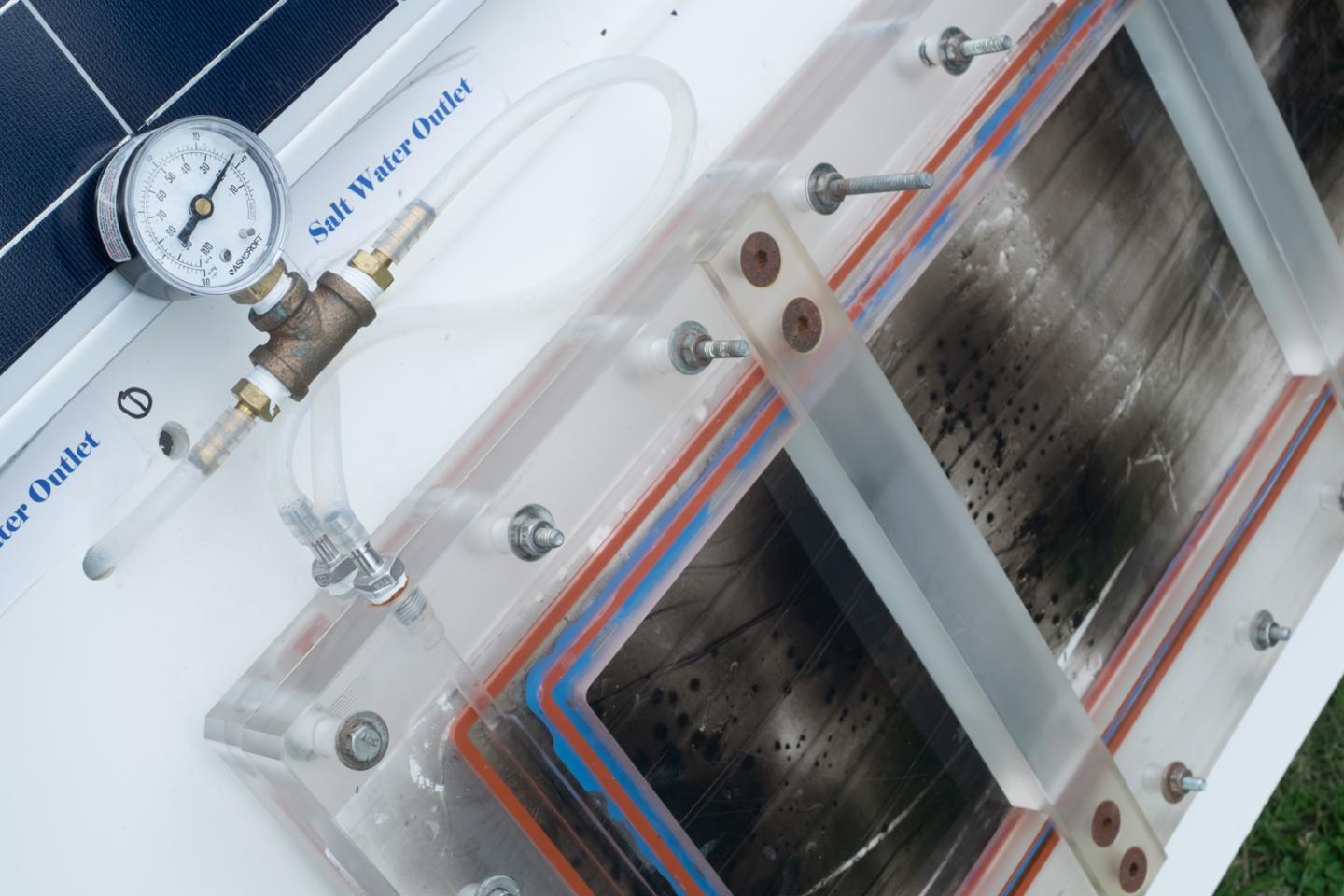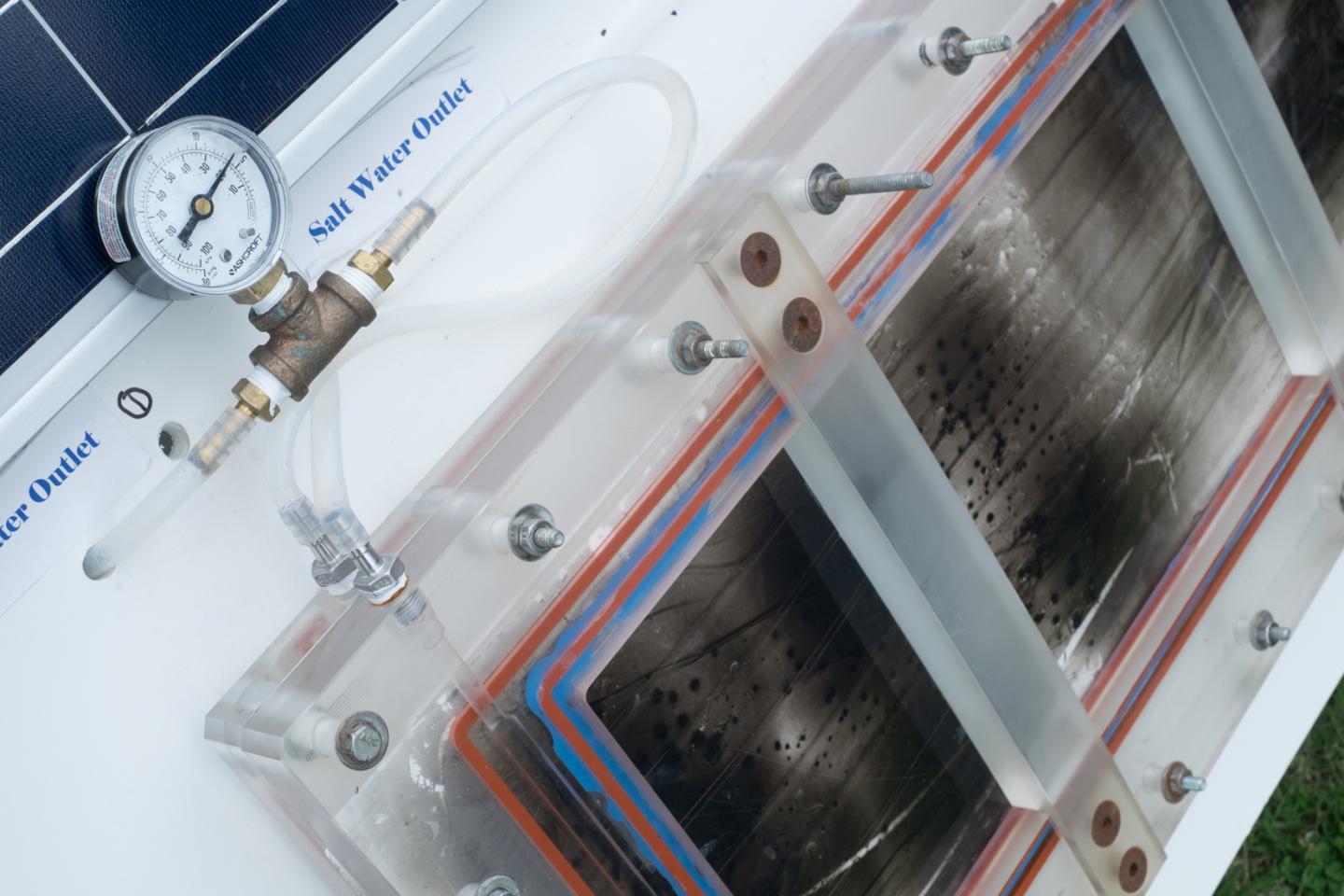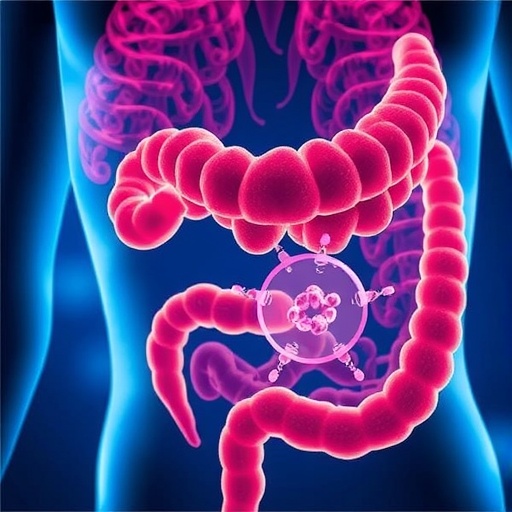
Credit: Jeff Fitlow/Rice University
HOUSTON — (June 25, 2018) — The Department of Energy (DOE) has awarded $1.7 million to a Rice University-led team for further development and field testing of an innovative desalination technology that uses nanoparticles and sunlight to treat water.
Rice's "nanophotonics-enabled solar membrane distillation" technology, or NESMD, is one of 14 projects funded June 19 through the DOE Solar Energy Technologies Office's Solar Desalination program.
NESMD combines tried-and-true water treatment methods with cutting-edge nanotechnology. By adding low-cost, commercially available nanoparticles to a porous membrane, the researchers essentially turn the membrane itself into a one-sided heating element that drives membrane distillation. The technology is in development at the Rice-based Center for Nanotechnology Enabled Water Treatment (NEWT), a multi-institutional engineering research center funded by the National Science Foundation.
"We're creating off-grid systems to provide water anywhere it's needed," said NESMD inventor and NEWT Co-director Qilin Li, a professor of civil and environmental engineering at Rice.
The oldest method of desalination is boiling brine and capturing the steam, which turns into fresh water after it cools. But boiling large volumes of water takes energy, so much so that energy costs account for the majority of operational expenses for thermal desalination plants. Membrane distillation is a lower-energy alternative in which hot brine is flowed across one side of a porous membrane and water vapor is drawn naturally through the membrane to the other side, where the temperature is lower.
NESMD builds upon membrane distillation by incorporating light-capturing nanoparticles directly into the membrane. Li developed it with NEWT colleagues, including Rice Professor Naomi Halas, NEWT's lead researcher for photonics, whose lab pioneered the creation of light-harvesting nanoparticles that can convert sunlight into heat, and Yale University Professor Menachem "Meny" Elimelech, NEWT's lead researcher for membrane processes.
In 2017, Li, Halas, Elimelech and colleagues published results showing that laboratory-scale NESMD prototypes could desalinate water at a rate of up to 6 liters per hour per square meter of light-harvesting membrane. Li said many parts of the NESMD technology can be optimized to improve upon those results as the system is scaled up for operational field tests.
###
Li is the principal investigator on the DOE grant. Co-principal investigators include Elimelech, Carnegie Mellon University Associate Professor Meagan Mauter, and Joon Min, vice president of Irvine, Calif.-based Montrose Environmental Group.
VIDEO is available at:
High-resolution IMAGES are available for download at:
http://news.rice.edu/files/2017/06/170623_NEWT-desal21-lg-1gtt35a.jpg
CAPTION: A scaled-up NESMD test bed during a 2017 demonstration at NEWT, an NSF-funded engineering research center at Rice University. (Photo by Jeff Fitlow/Rice University)
http://news.rice.edu/files/2017/06/170623_NEWT-qilin-lg-2gvtpup.jpg
CAPTION: Water treatment expert Qilin Li is a professor of civil and environmental engineering at Rice University and co-director of the Center for Nanotechnology Enabled Water Treatment. (Photo by Jeff Fitlow/Rice University)
Other NEWT stories from Rice:
Science teachers get hands-on research experience at Rice, thanks to NEWT — June 18, 2018 http://news.rice.edu/2018/06/18/high-school-science-teachers-get-hands-on-research-experience-at-rice-thanks-to-newt/
Mat baits, hooks and destroys pollutants in water — March 21, 2018 http://news.rice.edu/2018/03/21/mat-baits-hooks-and-destroys-pollutants-in-water/
Rice U.'s one-step catalyst turns nitrates into water and air — Jan. 4, 2018 http://news.rice.edu/2018/01/04/rice-u-s-one-step-catalyst-turns-nitrates-into-water-and-air/
Magnetized viruses attack harmful bacteria — Aug. 1, 2017 http://news.rice.edu/2017/08/01/magnetized-viruses-attack-harmful-bacteria/
Freshwater from salt water using only solar energy — June 19, 2017 http://news.rice.edu/2017/06/19/freshwater-from-salt-water-using-only-solar-energy/
NEWT welcomes congressional reps, NSF director — April 21, 2017 http://news.rice.edu/2017/04/21/newt-welcomes-congressional-reps-nsf-director/
Rice undergrads make tasty water for rural Mexico — April 10, 2017 http://news.rice.edu/2017/04/10/rice-undergrads-make-tasty-water-for-rural-mexico/
NEWT researchers gather at Rice — May 31, 2016 http://news.rice.edu/2016/05/31/newt-researchers-gather-at-rice/
Rice, ASU, Yale, UTEP win NSF engineering research center — Aug. 10, 2015 http://news.rice.edu/2015/08/10/rice-asu-yale-utep-win-nsf-engineering-research-center/
This release can be found online at news.rice.edu.
Follow Rice News and Media Relations via Twitter @RiceUNews.
Located on a 300-acre forested campus in Houston, Rice University is consistently ranked among the nation's top 20 universities by U.S. News & World Report. Rice has highly respected schools of Architecture, Business, Continuing Studies, Engineering, Humanities, Music, Natural Sciences and Social Sciences and is home to the Baker Institute for Public Policy. With 3,970 undergraduates and 2,934 graduate students, Rice's undergraduate student-to-faculty ratio is just under 6-to-1. Its residential college system builds close-knit communities and lifelong friendships, just one reason why Rice is ranked No. 1 for quality of life and for lots of race/class interaction and No. 2 for happiest students by the Princeton Review. Rice is also rated as a best value among private universities by Kiplinger's Personal Finance. To read "What they're saying about Rice," go to http://tinyurl.com/RiceUniversityoverview.
Media Contact
Jade Boyd
[email protected]
713-348-6778
@RiceUNews
http://news.rice.edu





